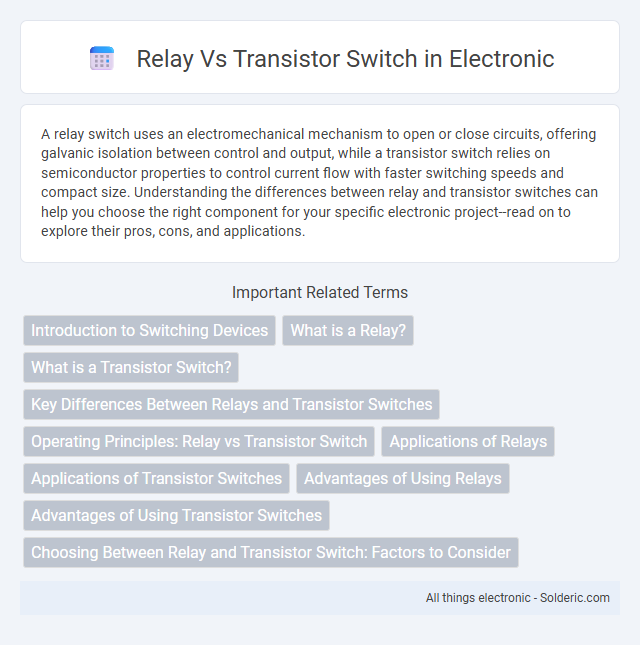A relay switch uses an electromechanical mechanism to open or close circuits, offering galvanic isolation between control and output, while a transistor switch relies on semiconductor properties to control current flow with faster switching speeds and compact size. Understanding the differences between relay and transistor switches can help you choose the right component for your specific electronic project--read on to explore their pros, cons, and applications.
Comparison Table
| Feature | Relay Switch | Transistor Switch |
|---|---|---|
| Operation Type | Electromechanical | Solid-state (Semiconductor) |
| Switching Speed | Slower (ms range) | Faster (ns to us range) |
| Control Signal | Requires coil current | Requires base/gate voltage |
| Load Isolation | Physical isolation (galvanic) | No physical isolation |
| Power Consumption | Higher (coil power needed) | Lower (minimal control current) |
| Contact Life | Limited (mechanical wear) | Longer (no mechanical parts) |
| Voltage & Current Rating | High voltage & current capable | Limited by semiconductor specs |
| Noise | Audible click | Silent operation |
| Size & Weight | Generally larger and heavier | Compact and lightweight |
| Cost | Higher due to mechanical parts | Lower, mass-produced |
Introduction to Switching Devices
Switching devices such as relays and transistor switches control electrical circuits by enabling or interrupting current flow. Relays utilize electromagnetic coils to mechanically open or close contacts for high-voltage or high-current applications, providing galvanic isolation between control and load circuits. Transistor switches, including bipolar junction transistors (BJTs) and MOSFETs, offer faster switching speeds and greater efficiency by electronically modulating current without moving parts, suitable for low-voltage and signal-level control.
What is a Relay?
A relay is an electromechanical switch that uses an electromagnetic coil to open or close contacts, enabling control of a high-power circuit with a low-power signal. It provides electrical isolation between the control circuit and the load, making it ideal for switching high voltages or currents safely. Relays are commonly used in automotive systems, industrial machinery, and home automation for their durability and ability to handle large loads.
What is a Transistor Switch?
A transistor switch is a semiconductor device that controls the flow of current in an electronic circuit by acting as a digital switch, turning on or off based on the input voltage applied to its base or gate. It offers faster switching speeds, greater durability, and lower power consumption compared to mechanical relays. When you need precise and reliable control in electronic applications, a transistor switch provides efficient signal amplification and switching without the noise and wear associated with relay contacts.
Key Differences Between Relays and Transistor Switches
Relays are electromechanical switches that use an electromagnetic coil to open or close contacts, providing electrical isolation between the control circuit and load, while transistor switches are semiconductor devices that control current flow digitally without mechanical parts. Key differences include switching speed--transistors operate faster than relays--and durability, as transistors have a longer lifespan due to the absence of moving components. Your choice depends on factors like load voltage, current requirements, noise immunity, and the need for electrical isolation.
Operating Principles: Relay vs Transistor Switch
Relays operate using an electromagnetic coil to mechanically open or close contacts, allowing them to switch high-voltage or high-current loads with electrical isolation between control and load circuits. Transistor switches function by using semiconductor junctions to control current flow electronically, providing faster switching speeds and smaller size but without inherent isolation. Your choice depends on the application's need for electrical isolation, switching speed, load type, and control signal characteristics.
Applications of Relays
Relays are widely used in applications requiring high voltage isolation and the ability to switch multiple contacts simultaneously, such as in automotive systems, industrial automation, and home appliances. Their robustness in handling inductive loads and capability to control high power circuits with low power signals make them ideal for motor control, lighting systems, and HVAC equipment. Relays also provide safety benefits by physically separating control circuits from high voltage loads, enhancing system reliability and protection.
Applications of Transistor Switches
Transistor switches are widely used in digital circuits for switching small loads like LEDs, small motors, and signal switching due to their high speed and reliability. They are essential in microcontroller-based designs where precise control of current flow and rapid switching are required. Your electronic projects benefit from transistor switches because they offer compact size, low power consumption, and easy integration with other semiconductor devices.
Advantages of Using Relays
Relays offer galvanic isolation between the control circuit and the load, enhancing the safety and reliability of your system. They can switch high voltage and high current loads with ease, which transistors may struggle to handle without additional components. Relays also provide a simple interface for controlling AC or DC devices and are less susceptible to voltage spikes that can damage semiconductor switches.
Advantages of Using Transistor Switches
Transistor switches offer faster switching speeds and greater reliability compared to relays, making them ideal for high-frequency applications. They consume less power and have no mechanical parts, reducing wear and extending the lifespan of your electronic circuits. Their compact size allows for more efficient circuit design and integration in modern devices.
Choosing Between Relay and Transistor Switch: Factors to Consider
Choosing between a relay and a transistor switch depends on load type, voltage, and switching speed requirements; relays excel in handling high-voltage and high-current AC loads with electrical isolation, while transistors are ideal for low-voltage DC switching with faster response times and longer lifespan. Consider factors like coil voltage, switching frequency, switching noise, and power consumption when designing circuits for industrial automation or electronic control systems. Reliability, physical size, and compatibility with microcontroller logic levels also play critical roles in selecting the appropriate switching component.
relay vs transistor switch Infographic

 solderic.com
solderic.com